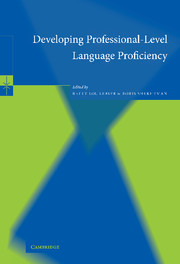Book contents
- Frontmatter
- Contents
- Notes on contributors
- Foreword
- Acknowledgments
- I Principles, practices, and theory
- II Programs
- 3 Contexts for advanced foreign language learning: a report on an immersion institute
- 4 Bridging the gap between language for general purposes and language for work: an intensive Superior-level language/skill course for teachers, translators, and interpreters
- 5 Learning Chinese in China: programs for developing Superior- to Distinguished-level Chinese language proficiency in China and Taiwan
- 6 Developing professional-level oral proficiency: the Shekhtman Method of Communicative teaching
- 7 The LangNet “Reading to the Four” Project: applied technology at higher levels of language learning
- 8 In the quest for the Level 4+ in Arabic: training Level 2–3 learners in independent reading
- 9 Teaching high-level writing skills in English at a Danish university
- 10 Heritage speakers as learners at the Superior level: differences and similarities between Spanish and Russian student populations
- 11 Teaching Russian language teachers in eight summer Institutes in Russian language and culture
- III Learners and users
- References
- Index
10 - Heritage speakers as learners at the Superior level: differences and similarities between Spanish and Russian student populations
Published online by Cambridge University Press: 03 December 2009
- Frontmatter
- Contents
- Notes on contributors
- Foreword
- Acknowledgments
- I Principles, practices, and theory
- II Programs
- 3 Contexts for advanced foreign language learning: a report on an immersion institute
- 4 Bridging the gap between language for general purposes and language for work: an intensive Superior-level language/skill course for teachers, translators, and interpreters
- 5 Learning Chinese in China: programs for developing Superior- to Distinguished-level Chinese language proficiency in China and Taiwan
- 6 Developing professional-level oral proficiency: the Shekhtman Method of Communicative teaching
- 7 The LangNet “Reading to the Four” Project: applied technology at higher levels of language learning
- 8 In the quest for the Level 4+ in Arabic: training Level 2–3 learners in independent reading
- 9 Teaching high-level writing skills in English at a Danish university
- 10 Heritage speakers as learners at the Superior level: differences and similarities between Spanish and Russian student populations
- 11 Teaching Russian language teachers in eight summer Institutes in Russian language and culture
- III Learners and users
- References
- Index
Summary
Taking stock at the beginning of this new century, it is clear that educational systems, including foreign language classrooms, will have to address a new and growing segment of the population of the USA, the bilingual community. According to the 2000 US Census information, almost 11% of Americans were born outside of the USA. In some states, the number is higher; for example, it is close to 26% in California. Due to migration, the processes of nationalism and federalism, the need for education, commerce, intermarriage, and other factors (Grosjean [1982]), languages in contact are becoming the norm rather than the exception, leading to increased bilingualism (Appel and Muysken [1987]).
The student population: toward a description
Speakers living in households that use more than one language at a high level of proficiency are considered bilinguals – although the term, bilingual, has many definitions and the concept of a bilingual individual as equally proficient in all aspects of two languages and cultures may be more myth than reality (Valdés [2000]). Various terms have been applied to bilingual L2 students. Home-background speakers and heritage learners are the terms used in this chapter to refer to those speakers who emigrated with their parents or were born to émigré families and who have a language of “a particular family relevance other than English” (Fishman [2001, p. 81]).
- Type
- Chapter
- Information
- Developing Professional-Level Language Proficiency , pp. 197 - 218Publisher: Cambridge University PressPrint publication year: 2002
- 2
- Cited by



